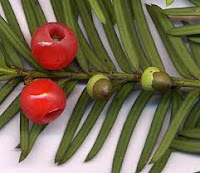The deodar is the national tree of Pakistan and is a member of the pine tree family in particular the cedars, making it a relative of the Biblical Cedar of Lebanon. As a member of the Pinaceae family of trees it is also related to the pine trees which bear pine nuts, including the chilgoza pine nuts. It is an evergreen coniferous tree that is native to Pakistan, Afghanistan, India and western Nepal. They can live for more than a thousand years, but up until now, they have not, as far as we know, beaten the Jurupa oakand the yew in the longevity stakes. The old trees can grow to heights of 250 feet and have girths of 14 feet. These trees are revered and can be found planted around temples.
The name deodar comes from a Sanskrit word, davadaru which means the timber of God or divine timber. However the tree is prized for its medical properties, and not just for its fragrant wood, which is, admittedly, put to many uses.
Walking through a forest of these trees is breathtaking as they emit the pine resin smell that scents the air. I see why it is used in aromatherapy to clear the mind. Because the wood is fragrant it is used like sandalwood for chests, and smaller items such as ornamental boxes and picture frames. Deodar wood repels insects and so chests and barrels are made to store grains such as rice in. The oil can also be diluted and sprayed on crops as a natural insecticide, and you can smear it over your arms to prevent them being bitten by mosquitoes.
 In former times in Pakistan, beggars pretending to be holy men would waft incense burners around shops for protection against evil and for good luck and inside the burners would be deodar charcoal or sandalwood. Now, however, they use any kind of charcoal and so their services are no longer welcomed. In fact they are not allowed in shops.
In former times in Pakistan, beggars pretending to be holy men would waft incense burners around shops for protection against evil and for good luck and inside the burners would be deodar charcoal or sandalwood. Now, however, they use any kind of charcoal and so their services are no longer welcomed. In fact they are not allowed in shops. Deodar oil and resins as well as the pine needles and bark of the tree have been used in traditional and Ayurvedic medicine for centuries, to cure illnesses ranging from STDs, cancer, rheumatoid arthritis to less serious coughs, colds and hiccups.
 |
| Deodar trees in winter |
Modern medical research has shown that extracts from the needles have a pain killing and antiseptic effect, and that the tree has antioxidant properties. It has been found to contain new lignan compounds (lignans are found in flax seeds, pumpkin seeds and broccoli and have antioxidant and anti-cancer properties). A new flavonoid has also been discovered, and the tree has also yielded two new types or sesquiterpenoids ά – and β-himachalines along with deodarone and deodardione.
Ayurvedic practitioners use preparations from the deodar tree to treat urinary tract problems, diabetes, obesity, to relieve pain, for skin problems, to aid digestion and to strengthen the heart muscles and to improve blood circulation. The oil is used for headaches, coughs, colds, hiccups, arthritis and a number of other ailments including gout.
 Rudyard Kipling mentions deodar trees in three of his books, and they have been mentioned frequently in Indian and Pakistani writings. Here are the quotations from Kipling.
Rudyard Kipling mentions deodar trees in three of his books, and they have been mentioned frequently in Indian and Pakistani writings. Here are the quotations from Kipling. “One of the young men of fashion - he who was found dead at the bottom of a well on the night of the earthquake had once given him a complete suit of Hindu kit, the costume of a low caste street boy, and Kim stored it in a secret place under some baulks in Nila Ram's timber-yard, beyond the Punjab High Court, where the fragrant deodar logs lie seasoning after they have driven down the Ravi.” (From “Kim”) Note: the Ravi is a river.
“The pass was crowned with dense, dark forest--deodar, walnut, wild cherry, wild olive, and wild pear, but mostly deodar, which is the Himalayan cedar; and under the shadow of the deodars stood a deserted shrine to Kali--who is Durga, who is Sitala, who is sometimes worshipped against the smallpox. “ (From “The Second Jungle Book”)
“He further increased his revenues by selling timber to the railway companies, for he would cut the great deodar trees in his own forest arid they fell thundering into the Sutlej River and were swept down to the Plains, 300 miles away, and became railway ties.”
(From “Mine Own People”)





















































